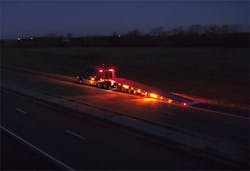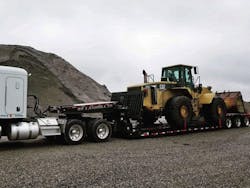Trailer safety regulations protect equipment and people: One mishap could mean the difference between completing a job effectively or endangering the driver and others on the road.
Low-boy equipment trailer safety techniques do not stray far from decades-long recommendations. Users understand that they must keep their trailers well maintained, and that drivers must understand safety directives.
“In three and half decades, I have seen a lot of changes,” says Jim Ladner, Landoll’s trailer sales manager. “Safety has driven most of the rules for usage. It is necessary to familiarize [yourself] with things like weight limits and proper tie down regulations.”
Federal and state weight regulations help prevent overloading, a common offense in trailering. Overloaded trailers can cause unsafe conditions leading to roadway accidents. They can also cause tire damage, as well as premature axle and bearing failure.
Conducting a detailed weight analysis before using a low-boy trailer will prevent overloading. First, drivers should know the trailer’s gross vehicle weight rating (GVWR) and towing truck gross combination weight rating (GCWR). The GVWR refers to the weight capacity of the vehicle alone. GCWR is a weight rating for both the vehicle and a hitched trailer.
To determine the available payload, users also need to know the curb weight of the empty trailer plus the curb weight of the towing vehicle. Curb weight refers to the total weight of an empty vehicle.
“Subtracting curb weights of the towing vehicle and trailer from the GCWR will give the maximum possible payload,” says Chris Lyon, the National Truck Equipment Association’s director of fleet relations.
If the truck’s GVWR is 10,000 pounds, for example, and weighs 6,000 pounds empty, payload capacity is 4,000 pounds.
Workers typically identify a calculated weight using an air or oil pressure gauge to determine the hydraulic load being exerted onto the trailer. Today, certain trailers have onboard scale systems that automatically calculate weight.
What equipment is required to be on a trailer?
Load scale systems and in-cab weight readings can help operators ensure loads meet weight regulations.
Landoll trailers, for example, use the AirWeigh load scale system, which calculates weight by measuring air pressure within the trailer’s airbags.
“If [the system detects an] overload on the axle, the driver may be able to relocate [the load] forward or back to change the weight on the axles so it becomes legal,” says Ladner. “Or [the user] can identify that they can’t legally transport that piece of equipment without a special permit.”
Some systems also provide in-cab weight ratings of both the trailer and the truck and payload, Ladner says.
Air ride suspensions also help maintain the equipment trailer’s appropriate ride height. According to Ladner, mechanical linkages adjust air pressure within the airbags by inflating and deflating based on weight of the equipment being hauled. As the user adds more weight, the system inflates the airbags to steady trailer height.
Operators must also properly tie down hauled equipment. Improperly secured equipment can shift loads, sway trailers, and place additional stress on the tow vehicle. Equipment may also come loose while traveling and, in some cases, fall off the bed completely.
Drivers should ensure their trailer’s tie downs are properly rated for the machine being transported. To start, the sum of the working load limits from all tie-downs must equal at least 50 percent of the weight of the cargo. When hauling a skid steer loader weighing 10,000 pounds, for example, drivers will need tiedowns that can support a minimum of 5,000 pounds.
U.S. Department of Transportation (DOT) tie-down regulations require drivers to restrain equipment with at least four tie-downs that can be made from a variety of material. The most common types are chains, wire rope, steel strapping, synthetic webbing, and cordage. Each tie down should fit within an appropriate working load limit (WLL), or maximum load a component should be subject to during use.
Equipment and trailer manufacturers provide designated tie-down areas on all equipment. Drivers must familiarize themselves with these areas to ensure the tie-downs are being placed appropriately.
“Landoll places chain keyhole slots in the frame as standard equipment, then customers can choose optional tie down rails along the edge of the trailer,” says Ladner. “So if the user is tying down a skid loader at 10,000 pounds, they’ll have to determine what number of tie downs will be required to secure that load.”
DOT regulations state that tie-downs should restrain equipment against movement in lateral, forward, rearward, and vertical directions. The equipment must be affixed as close as possible to mounting points.
“Your best advantage, and your strongest tie down angle with the most capacity, is going to be a 45 degree angle,” says Ladner. “Users should only use provided anchor points on the trailer, and the piece of equipment. If you tie in a different location on the equipment, it may not be a designed tie down location, and that could be an error on the driver’s part.”
Drivers should inspect the trailer’s chains and anchors before tying down equipment. Chains, binders, and tiedown devices must be in good operating condition, with no cracking, broken links, or damaged components. All securement anchors on the trailer should also be inspected.
Felling Trailers offers equipment-specific tie down locations upon request. This is useful for customers who haul one specific piece of equipment in the same location every time.
“We can semi-permanently affix chains and binders to the trailer’s tie downs,” says Nathan Uphus, sales manager. “All you have to do is hook it to the equipment and ratchet it down tight, and go on your way.”
Trailers must also have various lights and reflectors for on-road safety. Required lights for trailers 80 inches or wider, 30 feet or longer, and with a GVWR greater than 10,000 pounds must include two brake and turn signal lights, rear reflectors, rear side marker lights, and rear side reflectors. Clearance lights and side marker lights are also required.
Larger trailers also use reflective red and white conspicuity tape. Two pairs of rear upper body markings are required, along with one continuous bumper and lower body marking, and two continuous side markings.
Alongside these requirements, Landoll trailers feature additional LED marker lights for added visibility.
“Many of our customers operate along roadsides at night, and the lighting we use dramatically improves awareness of them,” says Ladner. “We even have lights that create walkways along the side of the trailer so drivers can see the ground at night. We can add lights to the deck so they can see to tie down their loads in the dark.”
According to Ladner, Landoll also enhanced its trailer’s rear-facing DOT lights by adding a fourth tail-turn light to the mud flap bracket.
“In most cases, the base regulation for marker lights is only needed on the four corners of the trailer,” Ladner says. “Landoll actually has up to 22 lights as markers on the trailer to improve roadside awareness.”
Landoll’s conspicuity tape also covers 90 percent of the trailer rather than the required 50 percent. This high-visibility light package is now standard equipment on all 400 and 800 series trailers.
“We wanted to add as much safety for them, to try to help minimize those incidents,” Ladner says. “Driver safety is important, and lights add safety.”






